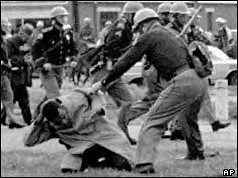
In 1964, Lewis coordinated SNCC's efforts for "Mississippi Freedom Summer," a campaign to register black voters across the South. The following year, Lewis led one of the most dramatic protests of the era. On March 7, 1965 -- a day that would become known as "Bloody Sunday" -- Lewis and fellow activist Hosea Williams led over 600 marchers across the Edmund Pettus Bridge in Selma, Alabama. At the end of the bridge, they were met by Alabama State Troopers, who ordered them to disperse. When the marchers stopped to pray, the police discharged tear gas and mounted troopers charged the demonstrators, beating them with night sticks. Lewis's skull was fractured, but he escaped across the bridge, to a church in Selma. Before he could be taken to the hospital, John Lewis appeared before the television cameras calling on President Johnson to intervene in Alabama.






No comments:
Post a Comment